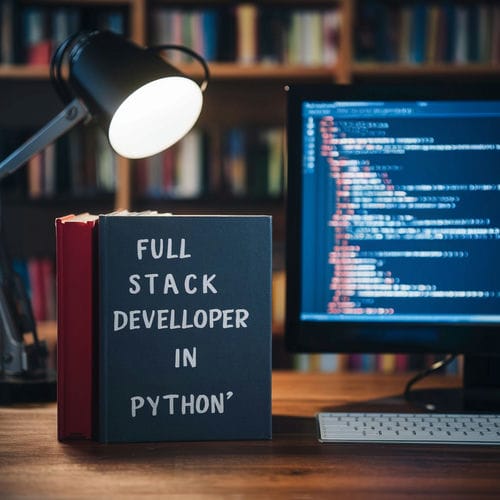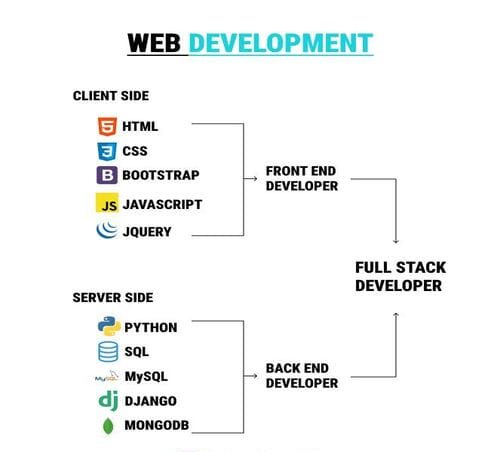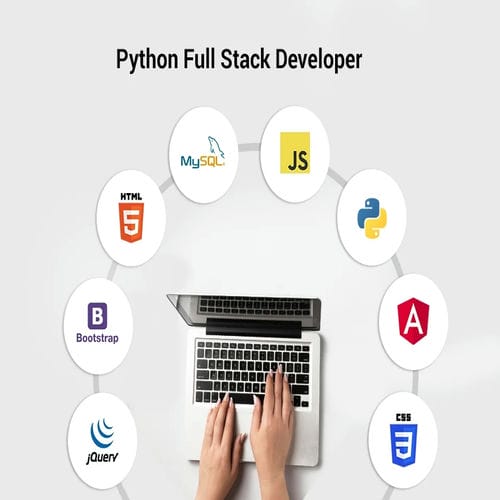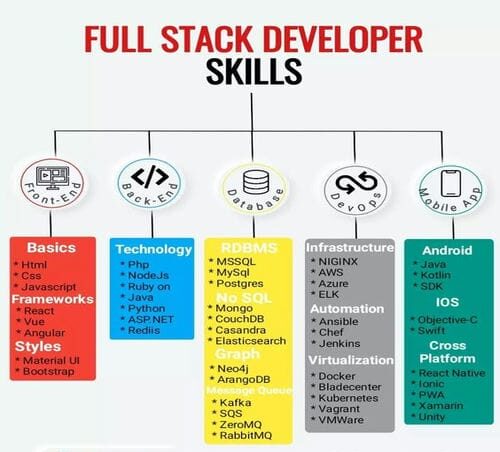Have you ever wanted to know what is full stack developer in python? It is more than just writing code; it is the enormous knowledge of both frontend and backend development that develops an integrated web experience.
This guide teaches you the world of full stack development for the concept of Python. As a full stack developer in Python, make delightful user interfaces, and architect fit server-side systems; your role will be as varied as it is exciting.
If you are ready to step into the full stack developer in python, where unlimited creativity unites limitless technical strength. Let’s dive in and uncover the secrets of becoming a master navigator in the vast ocean of full stack development with Python.
What is Full Stack Developer in Python?
Do you ever wonder who the magician making your favourite websites and applications work is? It’s the full stack developer – a tech. Proficient in both frontend and backend development. In today’s digital era where consumer experience is king, the role of a full stack Python developer has never been more critical.
1. Defining the Role
Imagine a full stack developer as a king when it comes to web development. They have the skills to create pretty interfaces but also a great ability to create strong server-side systems. They are the architects behind your digital visions, assembling them piece by piece.
2. Why Python? The Backbone of Full Stack Development
Considering the ease of use and flexibility, Python has become one of the preferable options for a full stack language. With an intuitive syntax and an abundance of libraries, this language seems like an ultimate weapon used to develop any part of the application: frontend, or backend. From creating a real-time web application to developing an API, working with a database – Python can handle all of it.
3. The Scope of Full Stack Development
Picture being able to glide over the complete web development life cycle, from concept to deployment. That is precisely what a full stack developer in Python can offers. By combining innovation with technical expertise, they can provide comprehensive solutions imagined by the end-users that can boost businesses.
Want to learn more about the domain of full stack development in Python? Join us as we explore and break down the future prospects and work areas in this thrilling field for new developers.

Frontend Development in Python
1. Crafting the User Experience
Ever wondered how your favourite websites or web-based applications achieve their unique designs and high-quality interactions? The answer lies in the work of frontend developers, the creators of a user interface. Frontend technologies play a significant role in full stack development as they are responsible for capturing the user’s attention upon entering a webpage.
2. Python’s Frontend Arsenal
Python is not only a powerful backend language; it has a strong grip in frontend development as well. Thanks to Python frameworks like Django and Flask, developers can easily create eye-pleasing and captivating UIs. Combine these with frontend frameworks React, Angular, or Vue.js, and you have a winning combination for creating a pleasant user experience.
3. Interface Design
Frontend development is more than just coding – it is narrative. It’s a narrative of architecture, appearance, and utility that the consumer lives through. Front-end Python developers transform static design concepts into dynamic user experiences by incorporating easy navigation menus and flexible layouts.
4. Empowering User Interaction
However, frontend development is not limited to aesthetics, punctuality. Python developers facilitate user behaviour and action through JavaScript ‘s competence, which includes dynamic objects, updating in real time, and abroad demands. Whenever it is a form input verification, data extraction from the API, or interactive animation development, JavaScript is the integral workhorse of frontend.
Backend Development in Python
1. Powering the Engine
The user-facing part of the apps gets developed through frontend development, while the magic behind the scenes comes from backend development. Picture it like the engine running a car– it helps power data to store and processes requests. In the world of full stack development, mastering backend technologies is key to building responsive and powerful web applications.
2. Python’s Backend Ecosystem
However, Python is useful for more than just front-end programming. Python is a powerful backend language. While working with frameworks such as Django and Flask, with their powerful toolkit, Python programmers can build everything from simple APIs to comprehensive web applications.
Furthermore, an abundance of libraries and modules are available to assist with tasks including database management, user authentication, and crypting make it extremely adaptable to the back end.
3. Architecting Data Solutions
At the core of backend development is data, the essence of modern applications. Python developers take an advantage of databases for Processing structured content into unformatted outputs such as SQLite, PostgreSQL, and MySQL. They build APIs that permit the sharing and Trading of data between the front end and backend.
4. Ensuring Security and Scalability
Nowadays, discouraging as it may seem, security is essential. Python backend developers protect the users’ sensitive information by encrypting passwords and following secure authentications methods. Furthermore, they build highly available and durable services, ensuring that the increase in the number of users and usage over time would not impact your system.
Are you excited to discover more about Python backend development? Get to know more about the data management, API design, and other state-of-the-art applications that fuel the modern web of services.

Full Stack Development Tools and Technologies
1. Navigating the Toolkit
A professional toolkit is invaluable when it comes to navigating the complexities of developing modern web applications. We will uncover the main tools and technologies that help full stack developers create living digital creatures.
2. Version Control Systems
It’s in version control systems such as Git that collaborative development is possible. More than one developer can work on the same codebase without seeing each other’s work. Branching, merging, version tracking, and all those wonderful capabilities introduced into Git make it possible for a full stack developer to perform all of this while working with their team.
3. Integrated Development Environments
For a full stack developer, an integrated development environment is a playground. It is a digital workspace where creativity and functionality are in constant harmony. IDEs such as PyCharm and VSCode include capabilities that make clean, efficient code several times simpler.
These features include, for example, syntax highlighting, code completion, and debugging, contained within a centralised location that makes keeping track of open projects and arranging files simple.
4. Containerization and Deployment Tools
After writing and testing the code, it is pretty much time to sail into the sea of production. Using containerization tools like Docker and orchestration platforms like Kubernetes makes deploying very straight forward, enabling full stack developers to pack everything in a portable container to deploy the application in different environments. Through containerization, developers can maintain the standards, increase the size of the software, and reduce dependency.
5. Testing Frameworks
Testing frameworks such as PyTest may be used to write easy-to-implement automation tests verifying that the functionality, performance, and reliability of the code are correct and working properly. Automation testing helps developers identify bugs early, make quick changes and deliver high-quality software to users.
6. Continuous Integration and Continuous Deployment (CI/CD) Pipelines
In the fast-paced world of web development, speed is of the essence. Another engineering tool is the CI/CD pipeline. The full stack developer has access to automated code building systems, tests, and deployment platforms.
This configuration allows developers to quickly and confidently ship new features and updates to production. In complex software development, full stack developers rely on CI/CD to speed up product engineering, minimise errors, and deliver exceptional user-driven value at record speed.

Skills and Qualifications of a Full Stack Developer in Python
1. Essential Skills for Full Stack Developers
Have you ever thought what it means to be a master navigator in the great open sea of full stack development? It’s not enough to know coding; you must have an extensive set of skills that ensure the ability to plot a path from the frontend to the backend and back. This article looks into what separates a full stack developer in Python regarding skills and qualifications.
2. Proficiency in Python Programming Language
Encompassing full stack development is a profound understanding of the Python programming language. As such, full stack developers should be able to understand Python syntax, data structures, and algorithms and use Python’s flexibility to develop dynamic web applications and strengthened backend systems.
3. Knowledge of Frontend and Backend Technologies
Full stack developers known as the ultimate navigators. Full stack developers are the connection between frontend and backend development. They are experts in frontend technologies, such as HTML, CSS, and JavaScript, as well as backend frameworks, including Django and Flask. With expertise in both languages of web development, full stack developers can build end-to-end solutions that wow users and fuel business growth.
4. Understanding of Web Development Principles and Best Practices
Web development is an ever-changing world where principles and best practices are not immutable; rather, they are guiding stars that lead to success. Full stack developers must master such concepts as responsive design, RESTful architecture, and the MVC pattern to create web applications that are scalable, maintainable, and user-friendly.
5. Problem-Solving and Troubleshooting Skills
Full stack developers should be great problem-solvers. From basic code debugging and fixing technical glitches to solving complex issues and challenges, a full stack developer must think critically, analyse the problems, and offer creative and efficient solutions to stay afloat.
6. Communication and Collaboration Skills
However, in the world of full stack development, being brilliant is more than just individual success. It is the product of strong communication. Full stack developers must also be able to communicate effectively, articulate ideas, give and receive feedback, and work cooperatively with those coming from a different field of understanding. Implementing a true culture of cooperation ensures that full stack developers glide smoothly across the stormy seas of web development.

Career Opportunities for Full Stack Developers in Python
1. Exploring Career Horizons in Full Stack Development
Are you ready to embark on an exciting career journey? Whether you’re a seasoned developer for startup businesses or a newcomer for established companies, Python’s full stack developer career is full of challenges. Time to explore the endless potential of programming that has offered to talented crews like yourself!
2. Demand for Full Stack Developers in Various Industries
Moreover, it is worth to say that modern full stack developers are in demand in any industry and area. No matter, it is e-commerce or financial, healthcare or entertainment, high-quality web applications, and great user experience, reliable, and fully optimised backend systems are very popular everywhere in the world. Hence, the development and growth of many different industries depend on talented professional full-stack developers.
3. Job Roles and Titles Associated with Full Stack Development in Python
A full stack developer in Python isn’t just one job title – it’s one multi-faceted professional who’s equipped to take on different roles. Whether frontend-focused jobs such as UI/UX developer and frontend engineer or backend-centric ones such as software engineer and backend developer, the career opportunities for full stack developers are as varied as the projects they face.
4. Salary Trends and Growth Opportunities
The competitive nature of tech talent makes Python Full Stack developers highly competitive, and it receives much greater compensation. The more the companies looking for competent and more developers, the higher they are willing to pay, accommodate, and sponsor to hire the best developers.
Whether your intention is to climb the corporate ladder or start your successful business as a freelancer or entrepreneur, Full Stack development has unlimited opportunities for developers who love exploring. It all begins with skilled developers in the vibrant domain of web development with Python.
Conclusion
As you set on your own journey, may you accept the challenges, celebrate the victories, and never lose sight of the horizon. As we lower the anchor for our exploration of full stack development in Python, one thing is certain. That is, the journey of a full stack developer is equally as rewarding as it is thrilling. Be it mastery of frontend or backend technologies, entering the world of full stack development is a thrilling experience., challenge, and limitless opportunities. Therefore, whether you are a seasoned developer seeking to broaden your horizon or a newbie to immerse yourself in the realm of web development.
Becoming a proficient full stack developer in Python is an exciting journey filled with endless opportunities for growth and success. By mastering both frontend and backend technologies, you’ll unlock the power to create dynamic, user-centric web applications that leave a lasting impression. Let’s build the future of the web together!
Ready to embark on this transformative journey? Explore our comprehensive courses at Devtrain.co and start your path to becoming a skilled full stack developer today


